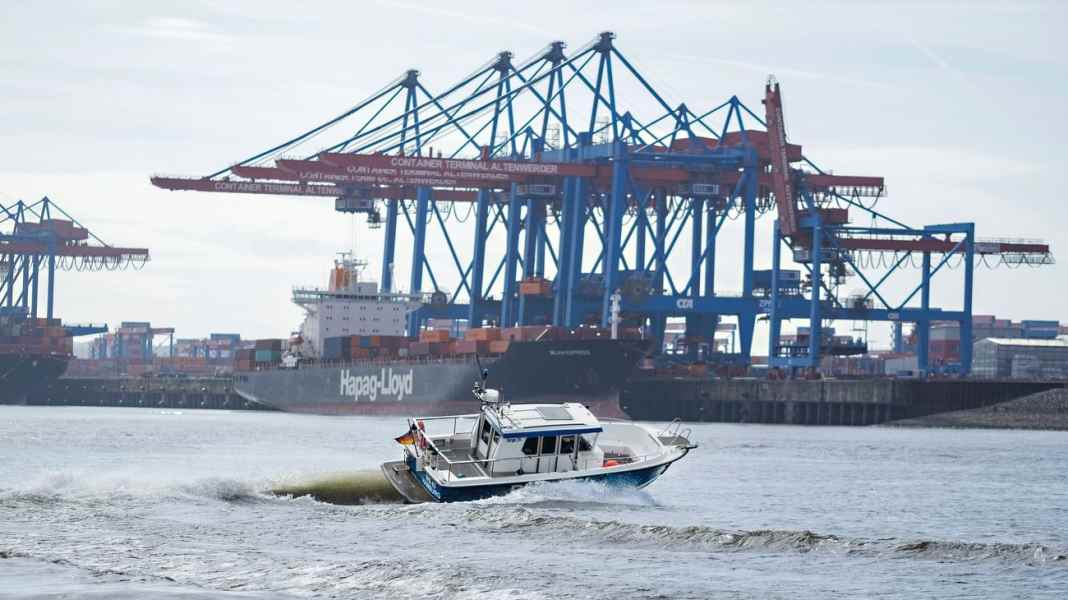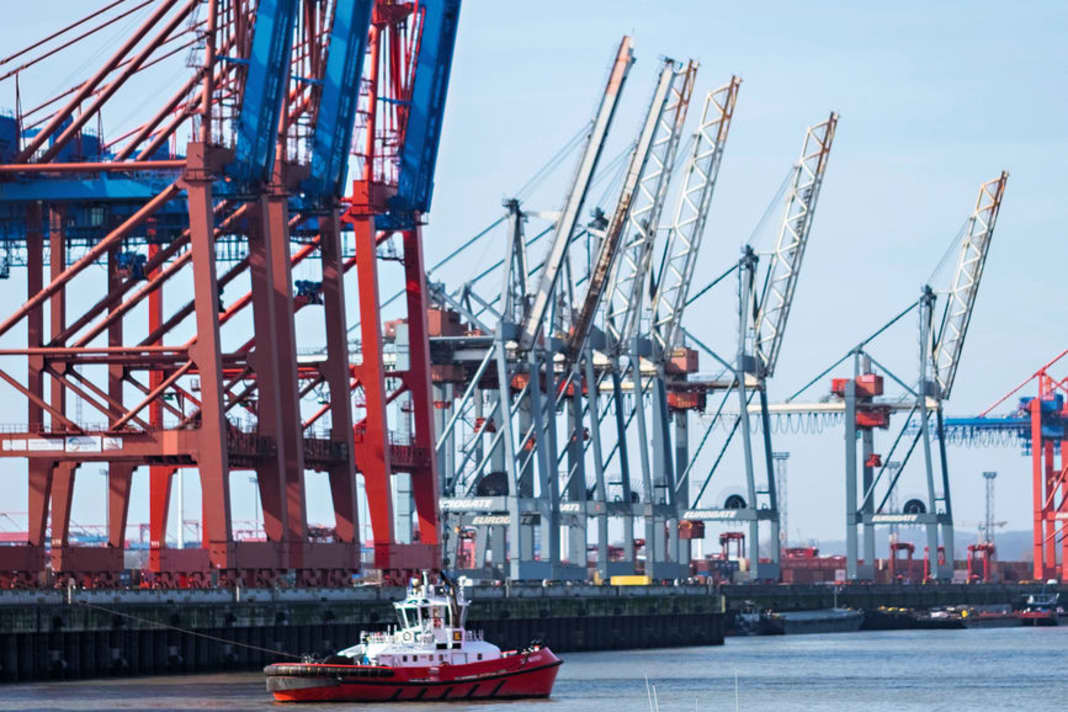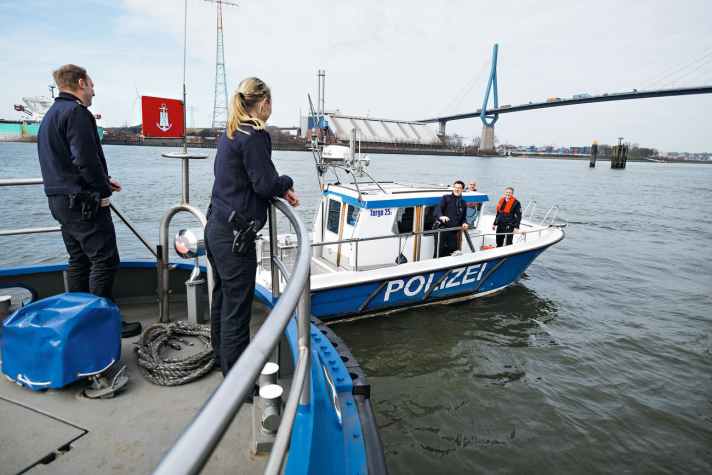Report: Waterway police - on duty at the gateway to the world

The most recent entry in the logbook of the patrol boat "WS 35" is still from six o'clock in the morning: the crew of the Hamburg water police had to help remove an aerial bomb from the Second World War.
The vast area between the Norderelbe and Süderelbe rivers that makes up Hamburg's harbour still conceals many dangerous unexploded bombs. When they come to light (which usually happens when new construction is underway), the pace of work slows down. And every interruption costs a lot of money.






This time, the focal point was Burchardkai in the Waltershof district, where the really big mega container freighters moor. Well over half a million of the standard steel boxes are moved at this terminal every year.
The old bomb was therefore threatening a particularly sensitive part of the harbour's economic engine - and until it could be rendered harmless by the explosive ordnance disposal specialists through targeted demolition, the greatest possible safety had to be ensured in a wide area beforehand.
And safety in the Port of Hamburg is the job of the waterway police. Although not every deployment of the officers has such a dramatic background, the variety of challenges still ensures a lot of variety on duty.
One of those in the know is Uta Kölling, who has just taken over from the early shift and started her day shift on board "WS 35" together with two other colleagues:
"One minute we're investigating oil pollution in the Elbe, the next we're dealing with a ship collision in a completely different part of the harbour. You never know what's coming next, what's behind the next operation.
That's what makes it so exciting for me", says the police superintendent, swivelling her binoculars over the banks on both sides and the traffic in the fairway ahead. "I've really never been bored in all my years of service."

Container terminals and storage sheds, railway tracks and brownfield sites, kilometres of quays and, of course, the river itself with its extensive network of harbour basins and canals - this is the territory of Uta Kölling and her colleagues.
However, it is not only Germany's largest seaport itself, but also a good "piece" more of the Elbe: the area of responsibility of the Hamburg Waterway Police extends from the barrage upstream at Geesthacht to the North Sea at Cuxhafen. The small islands of Neuwerk, Scharhörn and Nigehörn in the Elbe estuary are also part of the city area.
It is now nine o'clock. The smoke from the blast at Burchardkai three hours ago has long since cleared. The weather is clear, the sky cloudless. A beautiful, calm day, not necessarily typical for the north. But right from the start, the on-board radio gives the crew of "WS 35" no respite.
The freshly brewed coffee will have to wait for now: the harbour pilot from the HPA, the Hamburg Port Authority, requests assistance at Köhlbrand. This part of the Port of Hamburg is spanned by the wide concrete arch of the Köhlbrand Bridge, one of the city's landmarks. There are precisely defined regulations for the passage and meeting of vehicles here. All sea-going vessels are divided into traffic groups according to their length.
If a cargo ship measures more than 250 metres, the relevant section of the Süderelbe must be closed to traffic travelling in the opposite direction. "The giants have right of way at this critical point," says police inspector Marco Lewerenz, who is also part of the three-man crew of "WS 35" today. National and international regulations must be strictly adhered to in order to ensure the safety of all road users at all times.
"In our police jargon, we call this "shipping police enforcement tasks", adds skipper Andreas Wörner. "That sounds a bit dry, but it's not at all. Because sometimes decisions have to be made very quickly".
However, the Hamburg Waterway Police not only regulate traffic on the Elbe. Many tasks in the area of hazard prevention, the prosecution of criminal offences and administrative offences, as well as border police tasks in the clearance of seagoing vessels are just as much on the list of tasks as monitoring compliance with safety regulations on the water.

550 employees, spread across three police stations, one police district and several specialised departments, are available for this purpose. The fleet comprises around 30 vehicles. It ranges from a six-metre RIB to an almost 30-metre "coastal patrol boat".
With a length of just under 18 metres, "WS 35" lies roughly in the middle. It was built further up the Elbe in 2006 at a shipyard in Saxony-Anhalt and has since been in service with the Hamburg WSP along with two identical sister boats.
Incidentally, the history of the Hanseatic city's police force goes way back to the time of Napoleon: the French emperor had occupied the Hanseatic city for years. Then his troops withdrew from Hamburg and anarchy threatened to follow the military administration. On 25 May 1814, the Hamburg Senate therefore entrusted two senators with "handling the police and maintaining internal order". On land - and also on water.
Shortly before the end of the shift, another "big" task comes over the radio - in the truest sense of the word: a cruise ship is arriving. Full throttle from the south-west to the jetties. The 570-hp MAN diesel engine in the hull flexes its muscles. Nevertheless, caution is advised:
"There is also a speed limit for the police in the harbour. The maximum permitted speed for commercial shipping here is 10 knots, with some exceptions; the limit for pleasure craft is 12 knots".
The giant is escorted past the Elbphilharmonie concert hall by "WS 35" to its safe berth in Hafencity - this is also police work. Then the shift is over. "It's been busy again today," says skipper Wörner. The coffee cups from the morning are still half full next to the radio.

